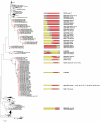A high variability of mixed infections and recent recombinations of hepatitis B virus in Laos
- PMID: 22383959
- PMCID: PMC3285149
- DOI: 10.1371/journal.pone.0030245
A high variability of mixed infections and recent recombinations of hepatitis B virus in Laos
Abstract
In Lao PDR, where more than 8% of the population are chronic carriers of HBsAg, multiple genotypes and subgenotypes co-circulate and are prone to generate recombinant viruses. Phylogenetic analyses of multiple clones per donor revealed mixed infections of subgenotypes B1, B2, B4, C1, C5, I1 and I2 in almost 6% of HBsAg positive rejected blood donors. Recombination analyses and distance calculations furthermore showed that about 65% (17/26) of the mixed infected donors showed recombinations in the S-gene alone, involving the predominant genotypes B and C. These results suggest that, at least in Laos, hepatitis B virus (HBV) mixed infections lead to frequent recombinations. In many donors with recombinant strains, the recombinant fragment and a non-recombinant strain of the same genotype co-existed (127/185 analysed recombinant fragments). For a large proportion of these (60/127), the most closely related known virus was found, although not always exclusively, in the same donor. Recombinant virus strains are largely distinct. This is reflected in an unexpected diversity in recombination breakpoints and the relatively rare recombinations with identical recombination patterns of the same genotypes in different donors. Recent recombination events would explain the limited spread of each of the recombinants. Using a published mutation rate of 4.2 × 10(-5) mutations per site and year, the observed minimum genetic distances of 0-0.60% between parent strain and recombinant fragment would correspond to 0-71 years of evolution from a most recent common ancestor (MRCA). Thus several lines of evidence are suggestive of recent independent recombination events, a proportion of these even occurring within the same donors. In conclusion, our analyses revealed a high variability of mixed infections as a very probable breeding ground of multiple variable recombination events in Laos that so far have not led to new dominant strains.
Conflict of interest statement
Figures


Similar articles
-
Molecular characterization of hepatitis B virus in blood donors from Burkina Faso: Prevalence of quasi-subgenotype A3, genotype E, and mixed infections.J Med Virol. 2016 Dec;88(12):2145-2156. doi: 10.1002/jmv.24589. Epub 2016 Jun 14. J Med Virol. 2016. PMID: 27253483
-
High prevalence of hepatitis B virus genotype C/C1 in the Minangkabau ethnic group in Indonesia.Virol J. 2013 Jan 22;10:27. doi: 10.1186/1743-422X-10-27. Virol J. 2013. PMID: 23336976 Free PMC article.
-
Molecular epidemiological study of hepatitis B virus among migrant workers from Cambodia, Laos, and Myanmar to Thailand.J Med Virol. 2010 Aug;82(8):1341-9. doi: 10.1002/jmv.21828. J Med Virol. 2010. PMID: 20572086
-
Hepatitis B virus intergenotypic recombinants worldwide: An overview.Infect Genet Evol. 2015 Dec;36:500-510. doi: 10.1016/j.meegid.2015.08.024. Epub 2015 Aug 20. Infect Genet Evol. 2015. PMID: 26299884 Review.
-
Concealed for a Long Time on the Marches of Empires: Hepatitis B Virus Genotype I.Microorganisms. 2023 Aug 31;11(9):2204. doi: 10.3390/microorganisms11092204. Microorganisms. 2023. PMID: 37764048 Free PMC article. Review.
Cited by
-
HBV genotypes and response to tenofovir disoproxil fumarate in HIV/HBV-coinfected persons.BMC Gastroenterol. 2015 Jul 8;15:79. doi: 10.1186/s12876-015-0308-0. BMC Gastroenterol. 2015. PMID: 26152237 Free PMC article.
-
Overview of hepatitis B viral replication and genetic variability.J Hepatol. 2016 Apr;64(1 Suppl):S4-S16. doi: 10.1016/j.jhep.2016.01.027. J Hepatol. 2016. PMID: 27084035 Free PMC article. Review.
-
Recombined sequences between the non-coding control regions of JC and BK viruses found in the urine of a renal transplantation patient.Virus Genes. 2012 Dec;45(3):581-4. doi: 10.1007/s11262-012-0815-9. Epub 2012 Sep 5. Virus Genes. 2012. PMID: 22948418
-
Distribution of Primary Resistance Mutations in Saint Petersburg in Patients with Chronic Hepatitis C.Diagnostics (Basel). 2022 Apr 22;12(5):1054. doi: 10.3390/diagnostics12051054. Diagnostics (Basel). 2022. PMID: 35626210 Free PMC article.
-
Hepatitis B virus genotypes: epidemiological and clinical relevance in Asia.Hepatol Int. 2016 Nov;10(6):854-860. doi: 10.1007/s12072-016-9745-2. Epub 2016 Jun 14. Hepatol Int. 2016. PMID: 27300749 Review.
References
-
- Kramvis A, Kew M, Francois G. Hepatitis B virus genotypes. Vaccine. 2005;23:2409–2423. - PubMed
-
- Norder H, Courouce AM, Coursaget P, Echevarria JM, Lee SD, et al. Genetic diversity of hepatitis B virus strains derived worldwide: genotypes, subgenotypes, and HBsAg subtypes. Intervirology. 2004;47:289–309. - PubMed
-
- Hannoun C, Norder H, Lindh M. An aberrant genotype revealed in recombinant hepatitis B virus strains from Vietnam. J Gen Virol. 2000;81:2267–2272. - PubMed
-
- Sa-Nguanmoo P, Tangkijvanich P, Thawornsuk N, Vichaiwattana P, Prianantathavorn K, et al. Molecular epidemiological study of hepatitis B virus among migrant workers from Cambodia, Laos, and Myanmar to Thailand. J Med Virol. 2010;82:1341–1349. - PubMed
Publication types
MeSH terms
Substances
LinkOut - more resources
Full Text Sources
Medical
Miscellaneous

